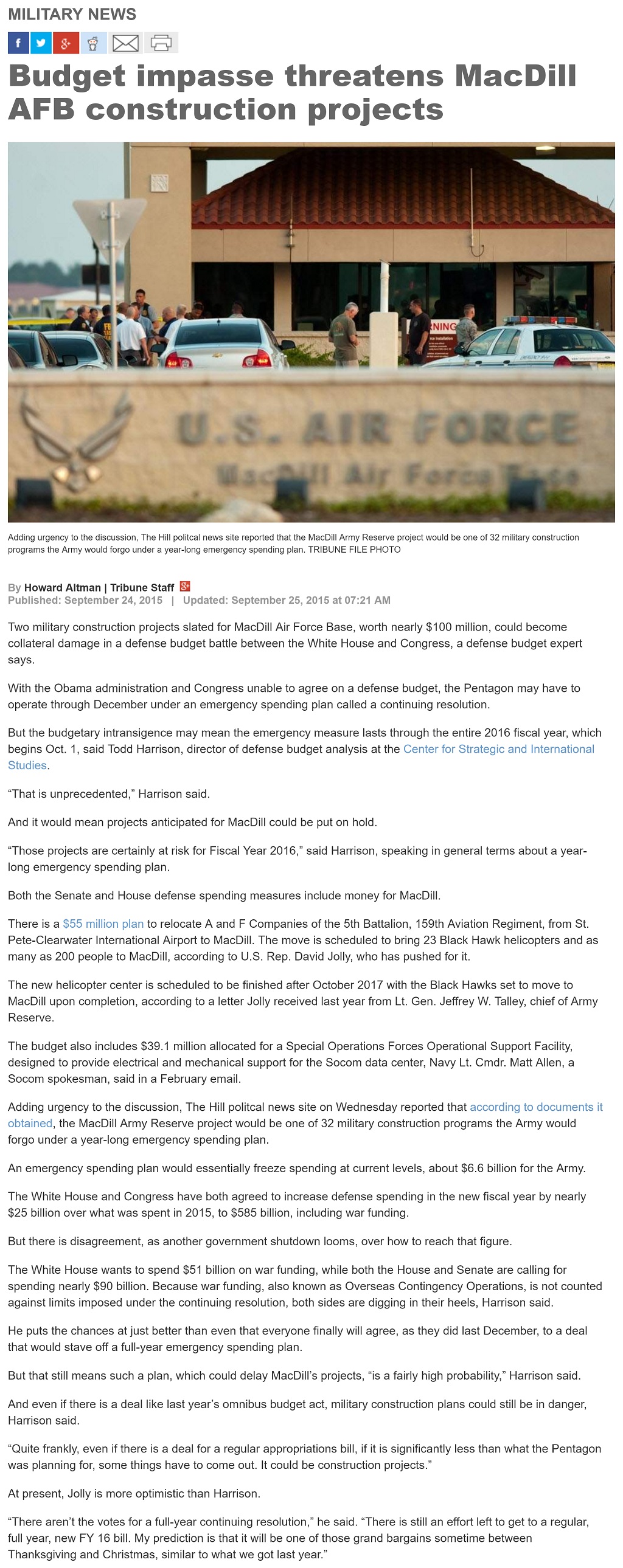
Two military construction projects slated for MacDill Air Force Base, worth nearly $100 million, could become collateral damage in a defense budget battle between the White House and Congress, a defense budget expert says.
With the Obama administration and Congress unable to agree on a defense budget, the Pentagon may have to operate through December under an emergency spending plan called a continuing resolution.
But the budgetary intransigence may mean the emergency measure lasts through the entire 2016 fiscal year, which begins Oct. 1, said Todd Harrison, director of defense budget analysis at the Center for Strategic and International Studies.
“That is unprecedented,” Harrison said.
And it would mean projects anticipated for MacDill could be put on hold.
“Those projects are certainly at risk for Fiscal Year 2016,” said Harrison, speaking in general terms about a year-long emergency spending plan.
Both the Senate and House defense spending measures include money for MacDill.
There is a $55 million plan to relocate A and F Companies of the 5th Battalion, 159th Aviation Regiment, from St. Pete-Clearwater International Airport to MacDill. The move is scheduled to bring 23 Black Hawk helicopters and as many as 200 people to MacDill, according to U.S. Rep. David Jolly, who has pushed for it.
The new helicopter center is scheduled to be finished after October 2017 with the Black Hawks set to move to MacDill upon completion, according to a letter Jolly received last year from Lt. Gen. Jeffrey W. Talley, chief of Army Reserve.
The budget also includes $39.1 million allocated for a Special Operations Forces Operational Support Facility, designed to provide electrical and mechanical support for the Socom data center, Navy Lt. Cmdr. Matt Allen, a Socom spokesman, said in a February email.
Adding urgency to the discussion, The Hill politcal news site on Wednesday reported that according to documents it obtained, the MacDill Army Reserve project would be one of 32 military construction programs the Army would forgo under a year-long emergency spending plan.
An emergency spending plan would essentially freeze spending at current levels, about $6.6 billion for the Army.
The White House and Congress have both agreed to increase defense spending in the new fiscal year by nearly $25 billion over what was spent in 2015, to $585 billion, including war funding.
But there is disagreement, as another government shutdown looms, over how to reach that figure.
The White House wants to spend $51 billion on war funding, while both the House and Senate are calling for spending nearly $90 billion. Because war funding, also known as Overseas Contingency Operations, is not counted against limits imposed under the continuing resolution, both sides are digging in their heels, Harrison said.
He puts the chances at just better than even that everyone finally will agree, as they did last December, to a deal that would stave off a full-year emergency spending plan.
But that still means such a plan, which could delay MacDill’s projects, “is a fairly high probability,” Harrison said.
And even if there is a deal like last year’s omnibus budget act, military construction plans could still be in danger, Harrison said.
“Quite frankly, even if there is a deal for a regular appropriations bill, if it is significantly less than what the Pentagon was planning for, some things have to come out. It could be construction projects.”
At present, Jolly is more optimistic than Harrison.
“There aren’t the votes for a full-year continuing resolution,” he said. “There is still an effort left to get to a regular, full year, new FY 16 bill. My prediction is that it will be one of those grand bargains sometime between Thanksgiving and Christmas, similar to what we got last year.”
PHOTO: Adding urgency to the discussion, The Hill politcal news site reported that the MacDill Army Reserve project would be one of 32 military construction programs the Army would forgo under a year-long emergency spending plan. TRIBUNE FILE PHOTO
